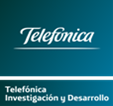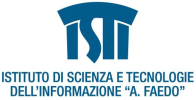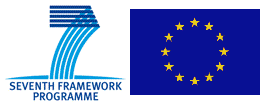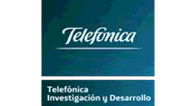Partners and Roles
The consortium is made up of the following 7 research and industry partners:
Telefónica I+D

Telefónica I+D is a company totally owned by Telefónica S.A. and operational since 1988. Telefónica S.A. has created Telefónica I+D to fulfil its Research and Development requirements with more excellence and profitability and to contribute to Telefónica Group competitiveness through technological innovation. Over the last years, the line of work of Telefónica I+D has evolved to conform to the objective of becoming a products & services creation unit. In particular, in this project, the Telefónica I+D unit that will take part in Serenoa is responsible for the specification and implementation of prototypes for Digital Home and E-Health environments. This objective is driven by research on interactive multimedia services, mobile communications, speech technology, multimodal interfaces in services, multidimensional context-awareness, seamless and ubiquitous services, multidevice services, adaptative services to user profiles and to the co-creation process.
Université catholique de Louvain (UCL)

Université catholique de Louvain (UCL) is represented in the Serenoa Project by the Louvain Interaction Laboratory (www.LILab.be), a laboratory conducting research, development, and consulting services in user interface engineering. For this purpose, the user interface development lifecycle is covered by a development methodology based on model-driven engineering, requirements engineering, prototyping, and evaluation. All steps are based on User Interface eXtensible Markup Language(www.UsiXML.org), a XML-complian tmeta-language for describing a user interface independently of any technology and explicitly based on usability guidelines. The Serenoa project will bring unique opportunities to address the challenge of multi-dimensional context-aware adaptation of service frontends towards a computational framework. In particular, three levels of adaptation will be addressed: adaptation rules, rules that govern adaptation rules, and strategies for choosing governing rules.
Consiglio Nazionale delle Ricerche / Istituto di Scienza e Tecnologie dell’Informazione “A. Faedo”

CNR-ISTI will participate to the project through the laboratory on Human Interfaces in Information Systems (http://giove.isti.cnr.it/). The main goal of this laboratory is to carry out research in methods and tools to support designers and developers to obtain usable service front ends that can be accessed from different contexts of use. For this purpose a set of languages (such as MARIA and ConcurTaskTrees), methods, and tools have been proposed to support development of multi-device interactive application at design time and adaptation and migration of interactive Web applications at run-time. Such languages and tools will be extended in Serenoa in order to obtain new solutions for service front-ends, able to dynamically compose access to various services, adapt to users, devices, social and physical environments, and exploit various interaction modalities. In addition, the design and development of context managers and usability evaluation frameworks for adaptive interfaces will be addressed as well.
SAP Research

SAP Research is the global technology research unit of SAP. The group significantly contributes to SAP’s product portfolio and extends its leading position in the market by identifying and shaping emerging IT trends and generating breakthrough technologies through applied research.
In contrast to SAP’s product groups and development labs that work on new functions and releases, the researchers explore opportunities that haven’t yet been developed into products.
SAP Research spreads its research and development activities around the globe. Currently, their thriving network comprises of 19 locations worldwide, including their headquarters in Walldorf, and numerous partners from the business and academic worlds. SAP Research will participate in the Serenoa project through the practice of Mobile Computing, Internet of Things and User Experience. Important topics are Gesture Recognition, Wearable Computing, Ambient Intelligence, Augmented Reality, Agile Usability Engineering Methods, Design Time Tools and Ontology-based UI Integration.
World Wide Web Consortium (W3C)
![]()
The World Wide Web Consortium (W3C) is an international consortium where Member organizations, a full-time staff and the public work together to develop Web standards to fulfil lW3C’s mission for leading the World Wide Web to its full potential.
It is widely recognized that user interface design is a challenging aspect of creating Web applications. The authoring tools market for this remains underdeveloped. There are expensive tools with proprietary formats, as well as programming language specific APIs, and a general lack of interoperability.
To address this, W3C is seeking to launch a newworking group focusing on the specifications that enable interchange of models across authoring tools and building upon extensive research into model-based design of user interfaces.
W3C will also contribute to building open source authoring tools and libraries that demonstrate the benefits of the model-based approach.
W4

W4 is an SME (60 persons) specializing in collaborative business applications. It is the BPM leader on the French market, but also specializes in automating the production of Graphical User Interfaces (GUIs) from models. Resulting applications target multiple graphical environments from a single model. Such models include the data structure and origin, the navigation tree and context related information. W4’s expectations from SERENOA are to be able to produce adapted GUIs from already existing applications. Two targets are considered a primary goal and targeted:
• Smartphones or tablets related GUIs (IOs and / or Android)
• Adaptation to users with disabilities (Dynamic update to various disabilities: color blind, low vision, impossibility to use the mouse …)
W4’s planned contribution is to implement a runtime engine in order to generate and / or show the adapted application in the specified environments described above. W4 is also responsible for managing the SERENOA industrial advisory board.
Fundación CTIC-Centro Tecnológico (CTIC-CT)

Fundación CTIC Centro Tecnológico is a technology center which has been dedicated to goals of general and social interest, of permanent nature and of cooperation for technology development. The aim and goal of the Foundation is the promotion and stimulation of activities related to the development of the ICT sector in all the aspects of the social and economical life, which can contribute to fostering and strengthening the Information Society. The main goals of CTIC in this project are:
• To collaborate in the building of the proposed framework, specially in the runtime tool.
• Disseminating the results of the project and transferring results to standard organizations.
• Co-editing scientific journals about the technology developed.
-
Twitter
- No public Twitter messages.
-
All about Serenoa
-
Funded by the European Commission

-
tags
Adaptation adaptive UI ambient intelligence Android Android SDK browser Brussels CASFE conference consortium context context-aware adaptation context-awareness CSS E-book Reader EICS elderly Events Facebook Fragments API framework HTML5 industrial panel iPad journal LREC MBUI Meeting Mobile Mobile Apps Model-driven models newsletter paper presentation review Review Meeting Serenoa standardization touch-based interaction TV UI W3C Working Group workshop



